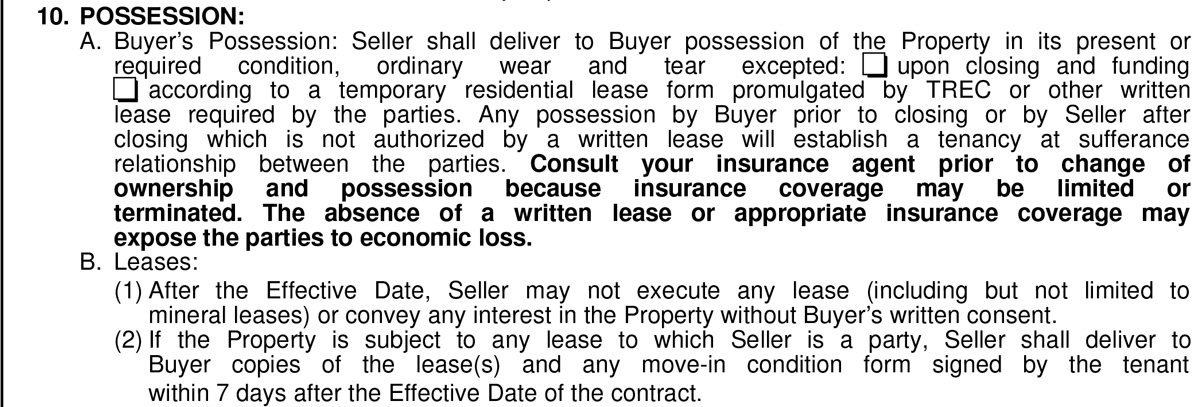 Note: The Texas Association of Realtors and TREC update promulgated forms regularly. For the most recent updates, check with TAR, TREC, or contact me at brian@starpointerealty.com.
Note: The Texas Association of Realtors and TREC update promulgated forms regularly. For the most recent updates, check with TAR, TREC, or contact me at brian@starpointerealty.com.
Note: I am a real estate professional, not a lawyer. Nothing herein should be construed as legal advice or instructions.
BLUF
- You can “move in” or “move out” either on the closing day or according to a short term lease.
- Schedule closings for mornings, and not on Fridays when possible.
- Be sure to review copies of leases during your option period if there are renters.
- An owner cannot lease a property during the contract without the buyer’s permission.
Previously in Paragraph 9: Closing we talked about the closing date, which is the date you are going to move in, right? Not necessary. Paragraph 10 deals with possession – when you get to move in.
Paragraph 10.A. Usually, a buyer will “possess” the property the same day they close on it. You get the keys at the closing table, the seller is moved out, and you move in! Note that the transaction is not complete until it funds. Usually it takes the title company a few hours after both buyer and seller have signed in order to fund, so if you are closing late in the day (or worst case, late on a Friday) it could be the next business day before it actually funds and you get (or give) the keys. Close in the morning, and not on Fridays when possible.
But the closing day may not always align exactly with what is most convenient for buyer or seller regarding moving into or from the property. In that case, you can have a temporary lease. If the buyer wants to move in before closing, you can negotiate a “Buyer’s Temporary Lease”. If the seller want’s to stay in the home after closing, you can have a “Seller’s Temporary Lease”.
I will discuss these more elsewhere. Generally, leases are very short, a few days to a week or two. The entire rent is paid upfront, with a security deposit, and usually the terms are more generous than what the market rent is, to compensate the buyer or seller for the risks involved in renting the property out (a default of the lease would require the entire eviction process, about 3-5 weeks’ time).
A “tenancy at sufferance” is essentially occupying the property illegally. If the buyer moves in before closing, or the seller stays after closing, then the other party can conduct an eviction. So no, buyers, you cannot move your belongings in before closing. The house ain’t yours.
If you are doing a lease, the “tenant” will probably want renters insurance or some coverage, and the “landlord” will want to be sure that their insurance covers damage by a renter.
Because leases are more complicated and higher risk (if the buyer moves in but fails to close, for example), many sellers decline a temporary lease. Builders also often do not allow them outright (thought it’s worth asking).
Paragraph 10.B. The seller is also required to give the buyers copies of any existing leases. Property managers will not give out lease information prior to an executed contract to protect the privacy of the tenants. But once under contract, it is imperative that they buyer be able to see and review those leases during the option period. When you buy a house, you buy the leases. Inspecting the lease is just as important as inspecting the home.
That leads into the first part of Paragraph 10.B. I think this is an oft-forgotten part of the contract. The seller cannot lease the property after the execution date without the buyer agreeing in writing. This protects the buyer. What if the seller leases the property the day before closing to a terrible tenant with terrible terms? Well, they can’t do that without the buyer agreeing. This protects the buyer from a bad lease.
This comes up often when a multi-family home (like a duplex or fourplex) is on the market for sale, and also has vacant rentals being advertised. The current owner usually is both selling the home and trying to rent the vacant units. Once under contract, however, they have to get the new buyer’s permission to lease a unit.
Next is Paragraph 11: Special Provisions, the bugaboo paragraph for agents that many don’t want to touch with a ten foot pole.
Had experiences with a temporary lease, good or bad? Please share in the Facebook comments for all to learn!

